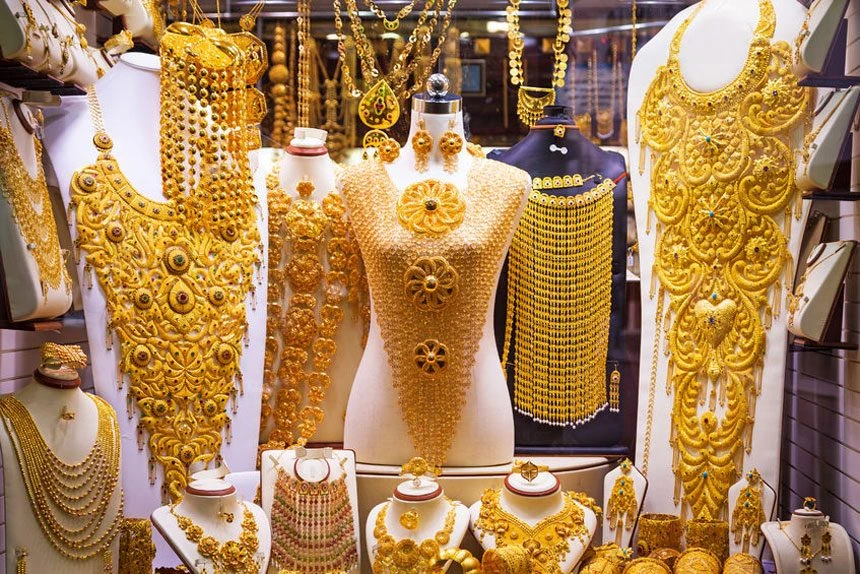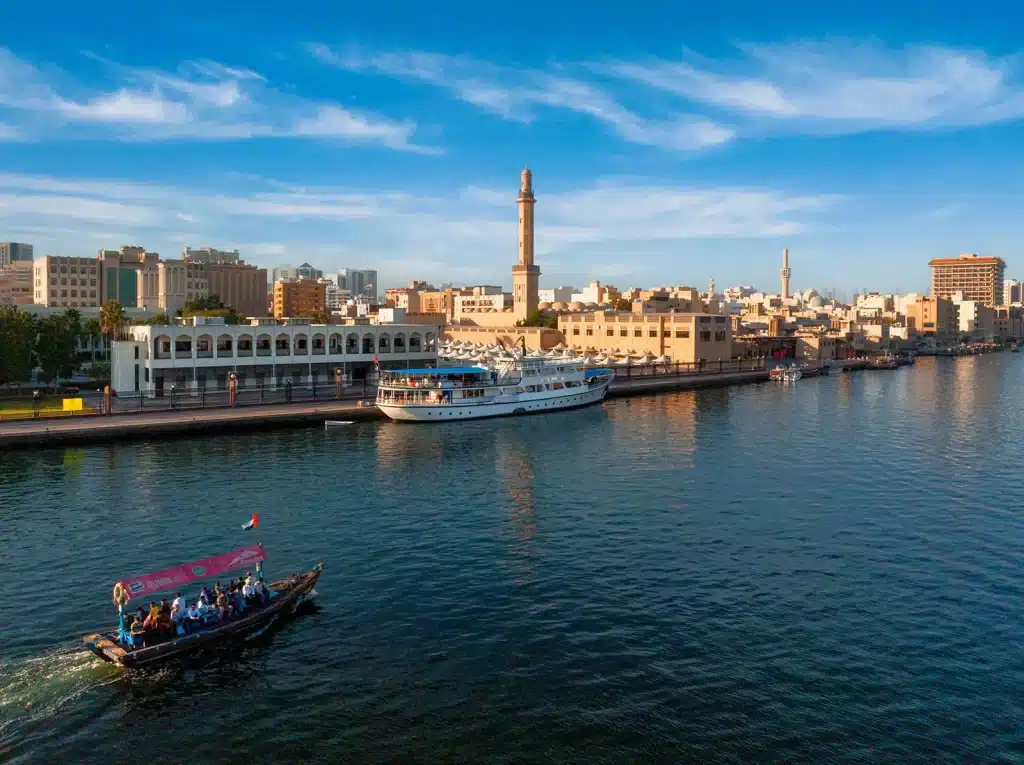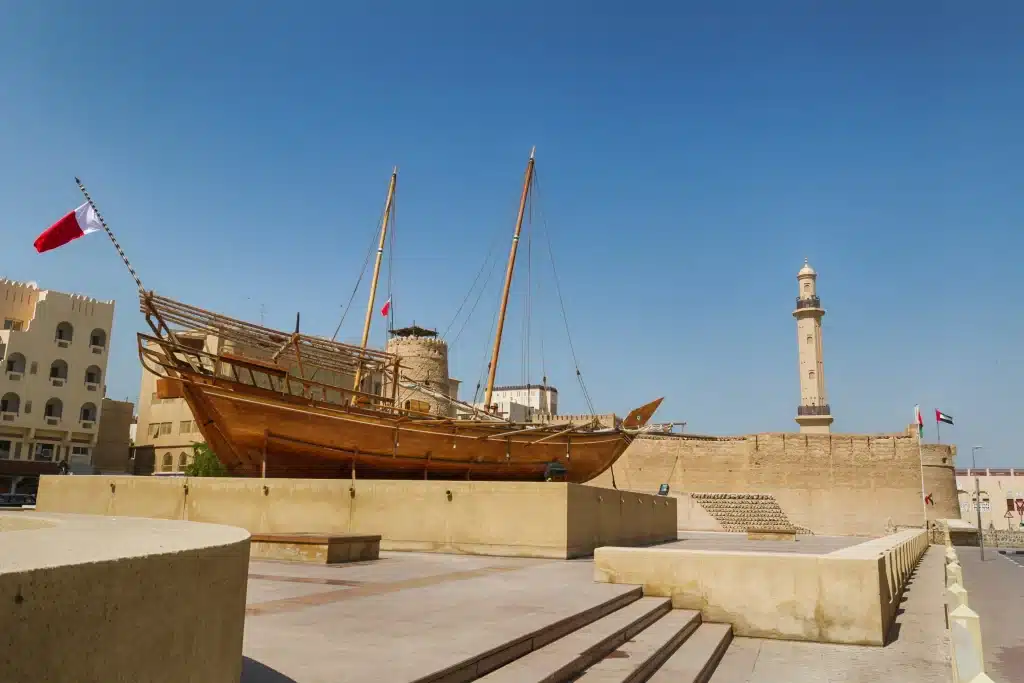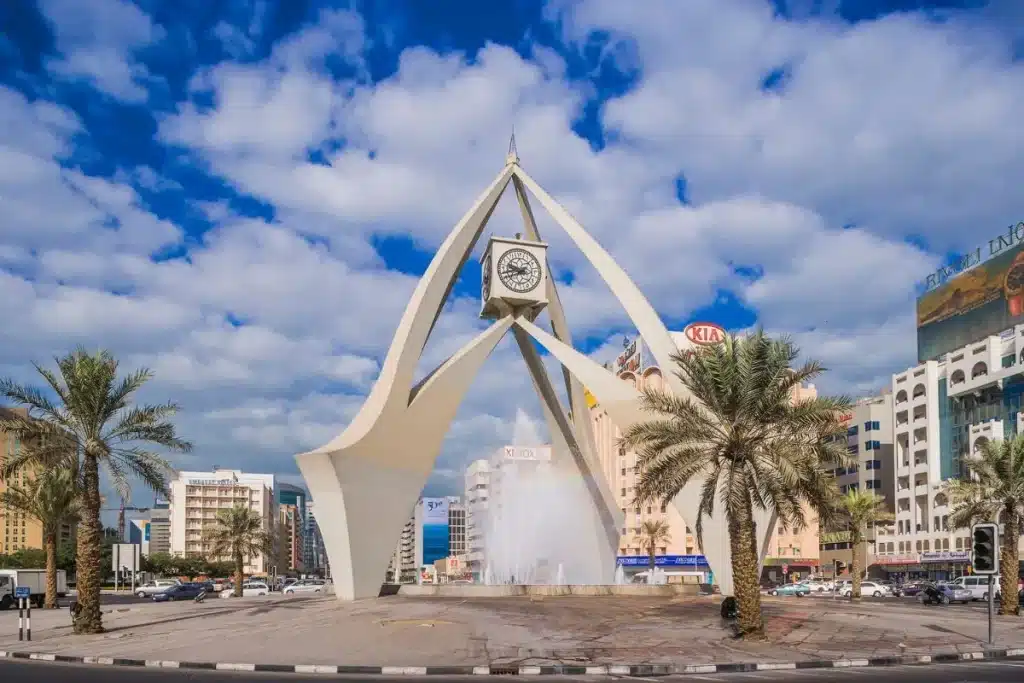Dubai’s iconic Clock Tower, officially known as the Deira Clocktower, stands as one of the city’s most recognizable landmarks and a testament to its rich history. Located at the intersection of Umm Hurair Road and Al Maktoum Road in the heart of Deira, this historic roundabout has been welcoming visitors and residents alike since its construction. The Daily Telegraph has even recognized it as one of the 17 most beautiful clock towers in the world, cementing its status as both an architectural marvel and cultural symbol.
The Clock Tower serves as more than just a timepiece; it’s a gateway to some of Dubai’s most authentic and culturally significant attractions. The surrounding Deira district represents the soul of old Dubai, where traditional markets, historic sites, and cultural experiences create an atmosphere that contrasts beautifully with the city’s modern skyline. This area offers visitors an opportunity to step back in time and experience Dubai as it once was—a bustling trading port where merchants from across the region gathered to exchange goods, stories, and traditions.
For travelers seeking to understand Dubai’s heritage while enjoying world-class attractions, the area around the Clock Tower provides the perfect starting point. The five attractions detailed below represent the cream of what this historic district has to offer, each providing unique insights into Emirati culture, history, and traditions that have shaped the UAE into the global destination it is today.
1. Dubai Gold Souk: The World’s Largest Gold Market

The Dubai Gold Souk, located just minutes from the Clock Tower, represents one of the world’s most spectacular jewelry markets and stands as the crown jewel of Dubai’s traditional shopping experience. This covered marketplace houses over 300 shops, making it the largest gold market globally and an essential destination for anyone visiting the Clock Tower area.
Walking through the Gold Souk feels like entering a treasure trove from Arabian nights. The narrow alleyways are lined with shops whose windows glitter with an astounding array of gold jewelry, from traditional Arabic designs to contemporary international styles. The souk specializes in 18, 21, and 22-carat gold, with prices fluctuating daily based on international gold rates, ensuring visitors always receive fair market value for their purchases.
What makes the Gold Souk particularly fascinating is its role in Dubai’s history as a trading hub. The market has operated for decades, serving both local Emiratis preparing for weddings and celebrations, and international visitors seeking unique pieces to commemorate their Dubai experience. The craftsmanship on display ranges from intricate traditional Arabic jewelry featuring geometric patterns and calligraphy, to modern pieces incorporating diamonds and precious stones.
Beyond shopping, the Gold Souk offers cultural insights into Arab traditions surrounding gold jewelry. In Emirati culture, gold plays a significant role in weddings, with families often gifting elaborate sets to brides. Visitors can observe this cultural practice firsthand while browsing the endless varieties of necklaces, bracelets, rings, and earrings.
The souk also features several shops specializing in precious stones and pearls, reflecting Dubai’s historic connection to pearl diving, which was once the region’s primary industry before oil discovery. Knowledgeable merchants are always willing to share stories about their craft and the cultural significance of different pieces, making each visit both educational and entertaining.
For photography enthusiasts, the Gold Souk provides countless opportunities to capture the interplay of light and precious metals, though visitors should always ask permission before photographing individual shops or merchants. The best times to visit are during the cooler evening hours when the souk comes alive with locals and tourists alike.
2. Dubai Spice Souk: A Sensory Journey Through Aromas and Flavors

Adjacent to the Gold Souk and equally accessible from the Clock Tower, the Dubai Spice Souk offers visitors an intoxicating sensory experience that captures the essence of Middle Eastern trading traditions. This historic marketplace has been serving the region for generations, providing both locals and restaurants with the finest spices, herbs, and traditional remedies from across the Arab world, India, Iran, and beyond.
The moment visitors enter the Spice Souk, they’re enveloped by an aromatic cloud of cardamom, cinnamon, saffron, and countless other spices that have made this region famous throughout history. The souk’s narrow corridors are lined with open sacks and decorative containers displaying colorful pyramids of spices, dried fruits, nuts, and traditional Arabic coffee.
What distinguishes the Dubai Spice Souk from typical tourist markets is its authentic role in daily Emirati life. Local families still come here to purchase ingredients for traditional dishes, and restaurant owners source their supplies from these same merchants who have perfected their craft over generations. Visitors can witness the continuation of trading practices that have remained virtually unchanged for centuries.
The variety available in the Spice Souk is staggering. Beyond common spices, visitors will discover black lemons (loomi) essential to Gulf cuisine, rose petals for traditional sweets, frankincense for religious and cultural ceremonies, and za’atar blends that vary according to family recipes. Many shops also stock traditional remedies and herbal treatments that reflect the region’s ancient knowledge of natural medicine.
Merchants in the Spice Souk are typically generous with samples and explanations, often sharing cooking tips and traditional recipes that accompany their products. This interaction provides invaluable cultural insights into Emirati cuisine and hospitality customs. Many visitors leave with not just spices, but with knowledge about how to prepare authentic Middle Eastern dishes.
The souk also serves as an excellent place to purchase unique gifts that capture the essence of Dubai. Saffron, often called “red gold,” makes for an exceptional souvenir, as do custom spice blends that merchants can create according to individual preferences. The packaging options range from simple bags to decorative containers that serve as beautiful reminders of the Dubai experience.
For those interested in photography, the Spice Souk offers incredible opportunities to capture the colors, textures, and cultural interactions that define traditional Arab markets. The interplay of light filtering through the covered walkways creates dramatic effects on the colorful spice displays.
3. Al Fahidi Historical Neighbourhood: A Window into Old Dubai

A short distance from the Clock Tower, accessible via the historic Al Maktoum Bridge or abra (traditional water taxi), lies the Al Fahidi Historical Neighbourhood, formerly known as Bastakiya. This meticulously preserved district offers visitors the rare opportunity to experience Dubai as it existed in the early 20th century, before oil discovery transformed the city into a modern metropolis.
The neighbourhood dates back to the 1890s when Persian merchants settled in the area, bringing with them distinctive architectural styles that included wind towers (barjeel) designed to naturally cool buildings in the desert climate. These traditional structures, built from coral stone and gypsum, represent some of the finest examples of Gulf architecture still existing today.
Walking through Al Fahidi feels like stepping back in time. The narrow alleyways wind between traditional courtyard houses, many of which have been converted into museums, galleries, cultural centers, and cafés while maintaining their historic authenticity. The Dubai Municipality has invested significantly in preserving this area, ensuring that renovation work respects original building techniques and materials.
One of the neighbourhood’s highlights is the Sheikh Mohammed Centre for Cultural Understanding, which offers cultural meals and programs designed to bridge understanding between different cultures. Visitors can participate in traditional Emirati breakfast or lunch experiences, learning about local customs while enjoying authentic cuisine in a historic setting.
The area also houses numerous art galleries showcasing both traditional and contemporary Middle Eastern art. These intimate spaces often feature works by local and regional artists, providing insights into how contemporary creators interpret traditional themes and cultural identity in the modern UAE.
Al Fahidi’s museums offer comprehensive looks at various aspects of Emirati culture. The Coffee Museum celebrates the importance of Arabic coffee in social and business interactions, displaying historic coffee-making equipment and explaining the rituals surrounding coffee service. The Coin Museum traces the monetary history of the region, while the Philatelic Museum showcases the UAE’s stamp collection.
The neighbourhood’s restoration includes authentic touches such as traditional Arabic architecture elements, including majlis (sitting areas), courtyards designed for extended family gatherings, and rooftop terraces that once provided sleeping areas during hot summer nights. These architectural details help visitors understand how families lived and adapted to the desert environment before modern cooling systems.
For visitors interested in shopping, Al Fahidi offers boutique stores selling traditional handicrafts, textiles, and artwork that reflect authentic Emirati culture rather than mass-produced tourist items. The prices tend to be higher than in the souks, but the quality and authenticity justify the investment for discerning collectors.
4. Dubai Creek: The Historic Waterway That Built a City

Dubai Creek represents the geographical and historical heart of Dubai, and its proximity to the Clock Tower makes it an essential attraction for any visitor to the area. This natural saltwater inlet has served as Dubai’s lifeline for centuries, enabling the trade that transformed a small fishing village into one of the world’s most important commercial centers.
The Creek divides old Dubai into two historic districts: Deira (where the Clock Tower stands) on the north side, and Bur Dubai on the south. This waterway stretches approximately 14 kilometers inland from the Arabian Gulf, creating a natural harbor that attracted merchants from India, Persia, and East Africa long before modern port facilities existed.
Today, visitors can experience the Creek through various means, each offering different perspectives on Dubai’s maritime heritage. The most authentic experience involves taking an abra, a traditional wooden water taxi that has been ferrying passengers across the Creek for decades. These boats, operated by experienced local captains, provide an affordable and atmospheric way to travel between Deira and Bur Dubai while observing the bustling waterway activity.
The Creek remains commercially active, with traditional dhows (sailing vessels) still loading and unloading cargo much as they have for generations. These wooden boats, often decorated with intricate carvings and colorful patterns, transport goods between Dubai and neighboring countries including Iran, India, and various African nations. Watching the loading process provides insights into trading practices that predate containerized shipping by centuries.
For those seeking more comprehensive Creek experiences, various tour operators offer dhow dinner cruises that combine sightseeing with traditional cuisine and entertainment. These evening cruises provide unique perspectives on both historic and modern Dubai, as the route passes traditional architecture alongside contemporary skyscrapers, creating a visual narrative of the city’s evolution.
The Creek also serves as an excellent starting point for exploring both sides of historic Dubai. From the Deira side near the Clock Tower, visitors can easily access the Gold and Spice Souks, while the Bur Dubai side offers attractions including the Dubai Museum and textile souk. The constant movement of abras makes it convenient to hop between attractions throughout the day.
Photography enthusiasts will find the Creek offers exceptional opportunities during different times of day. Morning light illuminates the traditional dhows and creates reflections on the calm water, while sunset provides dramatic backdrops for capturing the blend of old and new architecture. The activity level remains high throughout the day, providing numerous opportunities to capture authentic scenes of Dubai’s continuing maritime traditions.
The Creek area also features several waterfront parks and promenades perfect for leisurely walks while observing the maritime activity. These spaces often host cultural events and festivals, particularly during the cooler months, adding another dimension to the Creek experience.
5. Dubai Museum: Preserving Emirates Heritage

Housed within the historic Al Fahidi Fort on the Bur Dubai side of the Creek, the Dubai Museum stands as the emirate’s premier cultural institution and an essential complement to any Clock Tower area exploration. Built in 1787, the fort represents Dubai’s oldest existing building and provides the perfect setting for understanding the region’s transformation from a modest trading settlement to a global city.
The museum’s location in Al Fahidi Fort is historically significant, as this structure served as the ruler’s residence, government seat, and defensive fortification during Dubai’s early development. The fort’s thick walls, built from coral stone and shell mortar, represent traditional construction methods adapted to the harsh desert environment, while its strategic location near the Creek mouth provided optimal defensive positioning.
The museum experience begins in the fort’s courtyard, where traditional boats, including examples of the dhows that still ply the Creek, are displayed alongside historic weapons and architectural elements. This outdoor section provides context for the comprehensive indoor exhibitions that follow.
Underground galleries house the museum’s main exhibitions, which use multimedia presentations, dioramas, and authentic artifacts to tell Dubai’s story. The displays cover various aspects of traditional Emirati life, including pearl diving, which was the region’s primary industry before oil discovery. Detailed exhibits explain the dangerous and challenging nature of pearl diving, including the techniques, equipment, and seasonal patterns that governed this crucial economic activity.
Traditional crafts and trades receive extensive coverage, with working displays demonstrating how artisans created everything from pottery and metalwork to textiles and jewelry. These exhibits help visitors understand the skill levels and cultural knowledge required to thrive in the desert environment before modern technology and international trade transformed daily life.
The museum’s archaeological section displays artifacts from excavations throughout the UAE, some dating back 4,000 years. These findings demonstrate that the region has been continuously inhabited and has participated in international trade for millennia, contradicting misconceptions about the area’s history beginning only with oil discovery.
One of the museum’s most popular sections recreates a traditional souk, complete with life-sized figures, authentic sounds, and aromatic elements that transport visitors to Dubai’s commercial past. This immersive experience helps visitors understand how the modern Gold and Spice Souks evolved from similar historic markets.
The museum also addresses Dubai’s natural environment, including displays about desert ecology, traditional hunting practices, and the seasonal patterns that governed traditional life. Understanding these environmental factors helps visitors appreciate how Emirati culture adapted to one of the world’s most challenging climates.
For families visiting with children, the museum offers interactive elements and multimedia presentations that make learning about Emirati culture engaging for younger visitors. The combination of traditional displays with modern presentation techniques ensures that information is accessible to visitors with varying interests and attention spans.
The museum’s gift shop features authentic handicrafts, books about UAE history and culture, and educational materials that allow visitors to continue learning about Emirati heritage after their visit. Many items are produced by local artisans, making purchases a way to support traditional crafts while acquiring meaningful souvenirs.
Planning Your Visit to the Clock Tower Area
When planning a visit to these attractions around Dubai’s Clock Tower, several practical considerations can enhance the experience. The area is well-served by public transportation, with several Dubai Metro stations providing convenient access. The Union Metro Station and Al Ghubaiba Metro Station both offer relatively easy walking access to the Clock Tower and surrounding attractions.
The best times to visit are during the cooler months between October and April, when temperatures are more comfortable for walking between attractions. During summer months, early morning or late afternoon visits are advisable, as the midday heat can be challenging for extended outdoor activities.
Most attractions in the area operate throughout the week, though individual shop hours in the souks may vary. The Dubai Museum typically opens daily except Fridays, when hours may be modified. Checking current operating schedules before visiting ensures optimal planning.
The Clock Tower area represents Dubai’s authentic cultural heart, where visitors can experience the traditions, history, and commercial practices that shaped the modern UAE. These five attractions provide comprehensive insights into Emirati heritage while offering memorable experiences that contrast beautifully with Dubai’s reputation for modern luxury and innovation.
Whether seeking cultural education, unique shopping opportunities, or simply wanting to understand Dubai’s remarkable transformation, the attractions surrounding the historic Clock Tower provide an essential foundation for appreciating this remarkable city’s past, present, and future.


